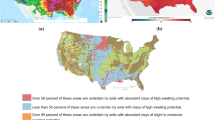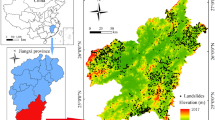Abstract
A reduction in the shear strength resulting from an increase in degree of saturation and pore pressures due to the infiltration of rainwater is often cited as a trigger for shallow slope failures. Models were prepared, in this study, to examine the influence of the density of the slope forming material and the inclination of the slope on the evolution of the seepage velocity, deformation mechanisms and stability of the clayey slopes. The relative compaction of the slope forming material ranged from 60% to 85% with slope inclinations ranging from 30 to 50°. The seepage velocity was found to decrease as the depth of the wetting front increased. Furthermore, the seepage velocity along the slope was greater than the seepage velocity at the head of the slope. The seepage velocity measured with tensiometers located throughout the slope matched well with the seepage velocity determined from the wetting fronts. When the relative compaction of the slope forming material was less than 75%, the slopes would tend to settle as the material became saturated with greater volumetric strains occurring in models with lower relative compactions. On the other hand, for slopes with relative compactions greater than 75%, the infiltration of rainwater would cause the slope to swell with greater negative volumetric strains at higher relative compactions.
Access provided by CONRICYT-eBooks. Download conference paper PDF
Similar content being viewed by others
Keywords
1 Background
Causing billions of dollars of property damage and hundreds of human casualties each year, landslides are one of the worst natural disasters. Although there are several factors that can trigger landslides, the most common throughout the world is rainfall. Guzzetti et al. [1] identified rainfall intensity-duration thresholds required to trigger landslides using statistical data analyses in different regions of the world. The thresholds will depend on a number of parameters including the soil type, slope gradient, and the relative compaction of slopes. The rate of infiltration of the rainwater into the ground, or the seepage velocity, will be one of the most important factors controlling the stability of the partially saturated slopes. Larger seepage velocities will result in a quicker movements of the wetting front, which will reduce suction and increase the unit weight of the slope material. Both of these changes will increase the likelihood of the slope instability. Factors including the density of the slope material, the inclination of the slope as well as the intensity and duration of the rainfall will impact the seepage velocity [2,3,4,5,6,7]. As part of this study, small scale experimental models were prepared in a Plexiglas container to examine the influence of the density of the slope material and duration of rainfall on the seepage velocity through the slope material and settlement experienced as a result of the rainfall.
2 Materials and Methods
2.1 Slope Material
For the preparation of the model slopes tested in this study, soil collected from a new construction project at the Titan Student Union at California State University, Fullerton was used. The properties of the slope material are presented in Table 1. The material was air-dried and sieved through the U.S. #4 sieve (sieve opening of 4.75 mm) prior to its use in the construction of any model.
2.2 Preparation of Model Slopes
The experimental slopes were prepared in a Plexiglas container. The preparation of the slope model began with the installation of a 7 cm thick drainage layer. The drainage layer consisted of pea-sized gravel. It was overlain by geotextile that was 5 mm thick and acting as a filter between the slope material and the drainage layer. The slope was constructed on top of this geotextile in 5 cm thick lifts. The total dry weight of material required to obtain the desired relative compaction was determined and mixed with an initial moisture content of 7.2% (3% dry of optimum). This material was, then, compacted to the desired lift thickness. All of the slopes were constructed to an inclination of 40°. Nine different model slopes were prepared at different relative compaction levels. The relative compactions used in each of these models are summarized in Table 2. The slope models were constructed in a larger Plexiglas container with interior dimensions of 1.2 m by 2.4 m and a height of 1.8 m. Some pictures from the model preparation process in the Plexiglas container are presented in Fig. 1.
After the slope was constructed to the desired height and required slope inclination, the slope was instrumented with eight miniature tensiometers and eight copper wires. The tensiometers had capacities to measure pore pressures from −180 kPa to 100 kPa. The copper wires were flexible and acted as inclinometers to determine the deformation in the slope. Figure 2 depicts the location of the instrumentation used in this study. The holes used to install the tensiometers were covered with a bentonite slurry in order to ensure that rainwater would not infiltrate rapidly through these holes. Three moisture sensors were also installed. The location of these moisture sensors are also included in Fig. 2. After the instrumentation was installed, the slopes were subjected to rainfall at an intensity of 30 mm/h using a rain simulator system. The location of the wetting front was recorded in 15 min intervals until the slope was completely saturated. Figure 3 contains some pictures of the instrumentation and the rain simulator system as well as the progression of the wetting front with time.
3 Results and Discussion
3.1 Wetting Front Locations
Presented in Fig. 4 is an example of the location of the wetting front with time recorded during the application of rainfall in Model 7. The movement of the wetting fronts were recorded on both sides as well as the back of the Plexiglas container. The seepage velocities were calculated at the tensiometer locations using the wetting front data as well as with the tensiometer data for comparison. The recordings in the tensiometers installed in Model 7 are shown in Fig. 5. These recordings give an indication of the movement of the wetting fronts inside of the soil mass and will approach a value of zero suction when the wetting front reaches the tensiometers.
Figure 6 contains a comparison of the time required for the tensiometers to obtain suction values of 0 kPa and the time required for the wetting front to reach the location of the tensiometers. Also included in Fig. 6 is a line representing that both times were equal. As it can be seen, the differences between the two measurements are similar in some of the cases, while in other cases time required to cease suction was slightly more than the time required for the wetting front to reach the tensiometer location. Such differences were expected as the location of the tensiometer and the, location where the weting front advancement was measured were slightly different.
The variation in the seepage velocity with relative compaction at the crest of the slopes is shown in Fig. 7. It can be seen from Fig. 7 that an increase in the relative compaction corresponded to a decrease in the seepage velocity when the relative compaction was greater than 63%. The seepage velocity in the model with a relative compaction of 60% appears to be lower than expected. However, this lower seepage velocity is attributed to the fact that the model slope experienced nearly 8% settlement in approximately the first hour after the application of rainfall. As a result, the slope material will densify impairing the infiltration of rainwater in the slope.
Figure 8 depicts the settlement and swelling experienced by the slopes as a result of the application of rainfall. In Fig. 8, the negative strain values represent settlement and positive strain values represent swelling of the slope. It can be seen that slopes with relative compactions initially less than 75% would experience settlement, while those with relative compactions initially greater than 75% would experience swelling with the application of rainfall.
4 Conclusions
Ten model slopes were prepared in Plexiglas container using soil obtained from a construction project at the Titan Student Union at California State University, Fullerton. The 40° inclined slopes were prepared to have different relative compactions ranging from 60% to 80% and were subjected to rainfall at an intensity of 30 mm/h. The location of the wetting front with duration of rainfall was recorded and used to determine the seepage velocity throughout the slope. The seepage velocity was found to decrease with an increase in the relative compaction. The model slopes were seen to experience settlement when the initial relative compaction was less than 75%, but would experience swelling when the initial relative compaction was greater than 75%.
References
Guzzetti, F., Peruccacci, S., Rossi, M., Stark, C.P.: Rainfall thresholds for the initial of landslides in central and southern Europe. Meteorol. Atmos. Phys. 98(3), 239–267 (2007)
Tiwari, B., Kawai, K., Caballero, S., Viradeth, P.: How rainfall and earthquake trigger shallow slides – experimental and numerical studies on laboratory prepared slopes. Int. J. Landslide Environ. 1(1), 109–110 (2013)
Tiwari, B., Lewis, A., Ferrar, E.: Experimental simulations of rainfall and seismic effects to trigger slope failures. Geotech. Spec. Publ. 231(1), 448–451 (2013)
Tiwari, B., Lewis, A.: Experimental modeling of rainfall and seismic activities as landslide triggers. Geotech. Spec. Publ. 225, 471–478 (2012)
Xue, K., Tiwari, B., Ajmera, B., Hu, Y.: Effect of long duration rainstorm on stability of red clay slopes. Geoenviron. Eng. 3(12), 1–13 (2016)
Tiwari, B., Caballero, S.: Experimental model of rainfall induced slope failure in compacted clays. Geotech. Spec. Publ. 256, 1217–1226 (2015)
Tiwari, B., Tran, D., Ajmera, B., Carrillo, Y., Stapleton, J., Khan, M., Mohiuddin, S.: Effect of slope steepness, void ratio and intensity of rainfall on seepage velocity and stability of slopes. In: Proceedings of the Geotechnical and Structural Engineering Congress, vol. 1, pp. 584–590 (2016)
Acknowledgements
The authors would like to thank California State University, Fullerton Instructionally Related Activities (IRA) Grant No. 3361 for the generous support provided to purchase the materials used in this study. Additionally, the efforts of the numerous students that assisted with the model preparation and data collection are greatly appreciated.
Author information
Authors and Affiliations
Corresponding author
Editor information
Editors and Affiliations
Rights and permissions
Copyright information
© 2018 Springer Nature Singapore Pte Ltd.
About this paper
Cite this paper
Tiwari, B., Ajmera, B., Khalid, M., Chavez, R. (2018). Stability and Deformation in Clayey Slopes with Varying Slope Density and Inclinations Subjected to Rainfall. In: Farid, A., Chen, H. (eds) Proceedings of GeoShanghai 2018 International Conference: Geoenvironment and Geohazard. GSIC 2018. Springer, Singapore. https://doi.org/10.1007/978-981-13-0128-5_11
Download citation
DOI: https://doi.org/10.1007/978-981-13-0128-5_11
Published:
Publisher Name: Springer, Singapore
Print ISBN: 978-981-13-0127-8
Online ISBN: 978-981-13-0128-5
eBook Packages: Earth and Environmental ScienceEarth and Environmental Science (R0)












